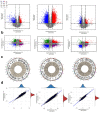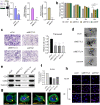N6-Methyladenosine RNA Modification Landscape in the Occurrence and Recurrence of Nasopharyngeal Carcinoma
- PMID: 36128587
- PMCID: PMC9451570
- DOI: 10.14740/wjon1491
N6-Methyladenosine RNA Modification Landscape in the Occurrence and Recurrence of Nasopharyngeal Carcinoma
Abstract
Background: Nasopharyngeal carcinoma (NPC) is a type of squamous head and neck cancer with variable geographic distributions, with the highest incidence in Southeast Asia. Its primary treatment is radiotherapy due to its high radio sensitivity. However, the N6-methyladenosine (m6A) landscape in NPC, including recurrent NPC, has not been reported.
Methods: In this study, m6A RNA immunoprecipitation (RIP) sequencing and microarray sequencing were performed on 12 tissue samples tissues of patients with primary and recurrent NPC. The expression profiles of m6A-related and non-coding RNAs were constructed and explored. Then, function experiments were performed to evaluate the effects of methyltransferase (METTL)3, METTL14 and WT1 associated protein (WTAP) on progressions of NPC. Finally, immunohistochemistry (IHC) and survival analysis were performed to confirm the correlation between METTL3, METTL14 and WTAP and NPC patients' clinical outcomes.
Results: This study mapped m6A RNA modification and RNA expression profiles in normal nasopharynx, primary NPC, and recurrent NPC tissues. This study also explored the role of m6A modificators in NPC development and recurrence. METTL3, METTL14, and WTAP could promote invasion and metastasis of NPC, and that these three proteins could induce radiotherapy resistance in NPC cells through DNA repair. Moreover, we found that METTL3, METTL14, and WTAP promoted an increase in exosomes within NPC microenvironment.
Conclusions: This study suggests that the alteration of m6A modification in primary and recurrent NPCs may play an important role in the development and progression of NPC.
Keywords: N6-methyladenosine; Nasopharyngeal carcinoma; Occurrence; RNA modification; Recurrence.
Copyright 2022, Wang et al.
Conflict of interest statement
The authors declare have no conflict of interest.
Figures





Similar articles
-
METTL3 regulates m6A in endometrioid epithelial ovarian cancer independently of METTl14 and WTAP.Cell Biol Int. 2020 Dec;44(12):2524-2531. doi: 10.1002/cbin.11459. Epub 2020 Sep 11. Cell Biol Int. 2020. PMID: 32869897
-
High expression of WTAP is related to poor prognosis in nasopharyngeal carcinoma.Neoplasma. 2023 Apr;70(2):229-239. doi: 10.4149/neo_2023_220828N871. Epub 2023 Mar 24. Neoplasma. 2023. PMID: 36964720
-
Mammalian WTAP is a regulatory subunit of the RNA N6-methyladenosine methyltransferase.Cell Res. 2014 Feb;24(2):177-89. doi: 10.1038/cr.2014.3. Epub 2014 Jan 10. Cell Res. 2014. PMID: 24407421 Free PMC article.
-
Function of N6-Methyladenosine Modification in Tumors.J Oncol. 2021 Nov 23;2021:6461552. doi: 10.1155/2021/6461552. eCollection 2021. J Oncol. 2021. PMID: 34858499 Free PMC article. Review.
-
Research advances of N6-methyladenosine in diagnosis and therapy of pancreatic cancer.J Clin Lab Anal. 2022 Sep;36(9):e24611. doi: 10.1002/jcla.24611. Epub 2022 Jul 15. J Clin Lab Anal. 2022. PMID: 35837987 Free PMC article. Review.
Cited by
-
World Journal of Oncology Has Gained an Impact Factor of 5.2 by Journal Citation Reports.World J Oncol. 2023 Aug;14(4):231-233. doi: 10.14740/wjon1687. Epub 2023 Aug 4. World J Oncol. 2023. PMID: 37560337 Free PMC article. No abstract available.
-
m6A modification-dependent upregulation of WNT2 facilitates M2-like macrophage polarization and perpetuates malignant progression of nasopharyngeal carcinoma.Oncogene. 2025 Aug;44(31):2730-2745. doi: 10.1038/s41388-025-03452-7. Epub 2025 May 26. Oncogene. 2025. PMID: 40419792
-
Effects of 131I and TSH suppression therapy on METTL3, METTL14 levels and recurrence in thyroid cancer.Am J Cancer Res. 2025 Jan 15;15(1):42-58. doi: 10.62347/THJB4749. eCollection 2025. Am J Cancer Res. 2025. PMID: 39949928 Free PMC article.
-
Epitranscriptomic RNA m6A Modification in Cancer Therapy Resistance: Challenges and Unrealized Opportunities.Adv Sci (Weinh). 2024 Dec 11;12(4):e2403936. doi: 10.1002/advs.202403936. Online ahead of print. Adv Sci (Weinh). 2024. PMID: 39661414 Free PMC article. Review.
-
Inhibiting the m6A Reader IGF2BP3 Suppresses Ovarian Cancer Cell Growth via Regulating PLAGL2 mRNA Stabilization.World J Oncol. 2024 Feb;15(1):100-113. doi: 10.14740/wjon1747. Epub 2024 Jan 10. World J Oncol. 2024. PMID: 38274714 Free PMC article.
References
-
- Liu YP, Wen YH, Tang J, Wei Y, You R, Zhu XL, Li J. et al. Endoscopic surgery compared with intensity-modulated radiotherapy in resectable locally recurrent nasopharyngeal carcinoma: a multicentre, open-label, randomised, controlled, phase 3 trial. Lancet Oncol. 2021;22(3):381–390. doi: 10.1016/S1470-2045(20)30673-2. - DOI - PubMed
LinkOut - more resources
Full Text Sources
Other Literature Sources
Miscellaneous
